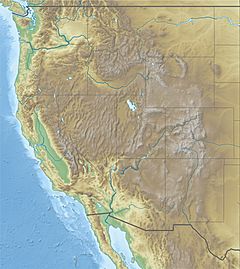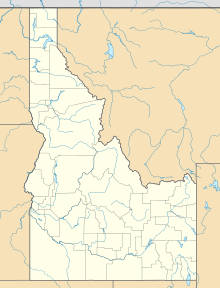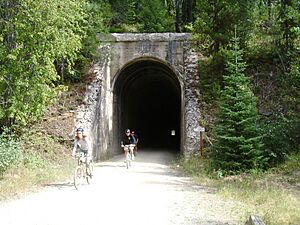St. Paul Pass Tunnel facts for kids
| Overview | |
|---|---|
| Location | Mineral County, Montana, Shoshone County, Idaho, U.S. |
| Coordinates | 47°23′20″N 115°38′59″W / 47.3890°N 115.6497°W |
| Status | Hiawatha Trail |
| System | Milwaukee Road Pacific Extension |
| Operation | |
| Work begun | 1906 (by the Chicago, Milwaukee & St Paul Railway Co. of Montana) |
| Operator | Milwaukee Road |
| Character | Rail until 1980, now non-motorized trail |
| Technical | |
| Length | 1.661 miles (2.673 km) |
| No. of tracks | Single |
| Gauge | Standard |
| Electrified | Yes |
| Highest elevation | 4,150 feet (1,265 m) at East Portal |
| Grade | 1.7% |
The St. Paul Pass Tunnel is a famous old railway tunnel located on the border of Montana and Idaho. It cuts through the Bitterroot Range, a part of the Rocky Mountains. For many years, trains from the Milwaukee Road rumbled through it.
Also known as the Taft Tunnel, this amazing tunnel is 1.66 miles (2.67 km) long. It was a key part of the railroad's path to the Pacific Ocean. When the railroad stopped running in 1980, the tunnel was given a new life. Today, it's a popular trail for hikers and bikers called the Route of the Hiawatha.
Contents
Building a Path Through the Mountains
At the start of the 1900s, the Milwaukee Road wanted to expand its railroad from the Midwest all the way to the Pacific coast. This was a huge project, and they were the last company to build a transcontinental line across the country.
Choosing the Perfect Route
Surveyors began searching for the best path in 1901. They needed a route that wasn't too steep for the heavy trains. The railroad wanted a grade (or slope) of no more than 2.2 percent. After exploring over 1,400 miles of land, they chose a path through the St. Paul Pass.
This route was chosen because it passed through forests full of valuable white pine timber. It was also in an area where no other railroads were operating. Even with all their hard work, the final route had a grade of 1.7 percent, which was steeper than competing railroad lines.
Digging the Tunnel
Work on the tunnel began in 1906. First, workers cleared the land leading to the tunnel entrances. Then, in 1907, the heavy boring and digging started. It was a tough job, but the tunnel was finally finished in December 1908.
The Milwaukee Road called it "Tunnel #20." At 8,771 feet (1.661 mi; 2.673 km) long, it was the second-longest tunnel on the entire line from Chicago to Seattle. Only the Snoqualmie Tunnel in Washington was longer.
The End of the Railroad Era
Building the railroad extension was very expensive. The company had to buy all the land themselves, unlike earlier railroads that got help from the government. The route also missed some big cities, which meant less money from passengers and cargo.
To make things even more challenging, the company decided to electrify the line through the mountains in 1914. This meant running electric trains instead of steam-powered ones, which were hard to operate on the steep grades. While this was innovative, it added to the high costs.
For years, the Milwaukee Road ran famous passenger trains like the Olympian Hiawatha through the tunnel. But the company always struggled with money. By the 1970s, things got worse, and in 1980, the Milwaukee Road had to abandon its tracks in Montana and Idaho, including the St. Paul Pass Tunnel.
A New Life as a Bike Trail
After the railroad left, the tunnel sat empty for over 20 years. But such a cool piece of history couldn't be forgotten! It was added to the Chicago, Milwaukee, St. Paul and Pacific Railroad Company Historic District to protect it.
On June 23, 2001, the tunnel reopened as the star attraction of the Route of the Hiawatha trail. Now, thousands of people visit each year to bike or walk through the dark, 1.66-mile-long tunnel. It's an adventure to travel through a tunnel that was once filled with the sounds of powerful trains.
Along the trail, you can still see other smaller tunnels, tall bridges, and even some of the old structures that held the wires for the electric trains.
The Wild Town of Taft
During the tunnel's construction, a small town called Taft popped up near the east entrance in Montana. From 1907 to 1910, Taft was known as one of the last "wild west" towns. It was a rough and lawless place far from the reach of the sheriff.
The town was supposedly named after William Howard Taft. Before he was president, he visited the work camp and was shocked by how wild it was. As a joke, the townspeople decided to name the town after him.
Taft was a temporary town filled with thousands of railroad workers and people looking to make a quick dollar. It was known for being a rowdy and sometimes dangerous place. The buildings were made of wood and built quickly.
The town's wild days came to a sudden end in 1910. A massive series of forest fires, known as the "Big Burn," swept through the area. As the fire approached, the people of Taft jumped on a special train and evacuated. The fire completely destroyed the town. Since the railroad construction was finished, there was no reason to rebuild it. Today, nothing is left of Taft except for an exit on Interstate 90 that bears its name.
See also
- Chicago, Milwaukee, St. Paul and Pacific Railroad
- Chicago, Milwaukee, St. Paul and Pacific Railroad Company Historic District
- Bitterroot Range
- Route of the Hiawatha Trail




